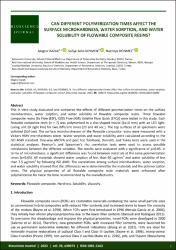| dc.contributor.author | Kazak, Mağrur | |
| dc.contributor.author | Köymen, Safiye Selin | |
| dc.contributor.author | Dönmez, Nazmiye | |
| dc.date.accessioned | 2023-05-24T06:06:04Z | |
| dc.date.available | 2023-05-24T06:06:04Z | |
| dc.date.issued | 2023 | en_US |
| dc.identifier.citation | Kazak, M., Köymen, S. S. ve Dönmez, N. (2023). Can different polymerization times affect the surface microhardness, water sorption, and water solubility of flowable composite resins? Bioscience Journal, 39. https://doi.org/10.14393/BJ-v39n0a2023-66895 | en_US |
| dc.identifier.issn | 1516-3725 | |
| dc.identifier.uri | https://doi.org/10.14393/BJ-v39n0a2023-66895 | |
| dc.identifier.uri | https://hdl.handle.net/20.500.12511/10961 | |
| dc.description.abstract | This in vitro study evaluated and compared the effects of different polymerization times on the surface microhardness, water sorption, and water solubility of flowable composite resins. Three flowable composite resins [Es Flow (ESF), IGOS Flow (IGF), Estelite Flow Quick (EFQ)] were tested in this study. Each flowable composite resin (n = 7) was polymerized in a disc-shaped mould (1x10 mm) with an LED light-curing unit (D Light Pro) for two different times (20 and 40 sec.). The top surfaces of all specimens were polished (Sof-Lex). The surface microhardnesses of the flowable composite resins were measured with a Vickers HMV microhardness tester. Water sorption and water solubility were calculated according to the ISO 4049 standard. One-way ANOVA and post hoc Tamhane, Dunnett, and Tukey tests were used in the statistical analyses. Pearson’s and Spearman’s rho correlation tests were used to assess possible correlations between the different variables. The results were evaluated with a significance of p<0.05. In terms of microhardness, a significant difference was found between materials at the same polymerizati on times (p<0.05). All materials showed water sorption of less than 40 µg/mm3 and water solubility of less than 7.5 µg/mm3 by following ISO 4049. The correlations among surface microhardness, water sorption, and water solubility showed that the differences were determined by the materials and the polymerization times. The physical properties of all flowable composite resin materials were enhanced after polymerization for twice the time recommended by the manufacturers. | en_US |
| dc.language.iso | eng | en_US |
| dc.publisher | University Federal de Uberlandia | en_US |
| dc.rights | info:eu-repo/semantics/openAccess | en_US |
| dc.rights | Attribution 4.0 International | * |
| dc.rights.uri | https://creativecommons.org/licenses/by/4.0/ | * |
| dc.subject | Flowable Composite | en_US |
| dc.subject | Hardness | en_US |
| dc.subject | Solubility | en_US |
| dc.subject | Viscosity | en_US |
| dc.title | Can different polymerization times affect the surface microhardness, water sorption, and water solubility of flowable composite resins? | en_US |
| dc.type | article | en_US |
| dc.relation.ispartof | Bioscience Journal | en_US |
| dc.department | İstanbul Medipol Üniversitesi, Diş Hekimliği Fakültesi, Restoratif Diş Tedavisi Ana Bilim Dalı | en_US |
| dc.authorid | 0000-0002-1733-9209 | en_US |
| dc.identifier.volume | 39 | en_US |
| dc.relation.publicationcategory | Makale - Uluslararası Hakemli Dergi - Kurum Öğretim Elemanı | en_US |
| dc.identifier.doi | 10.14393/BJ-v39n0a2023-66895 | en_US |
| dc.institutionauthor | Köymen, Safiye Selin | |
| dc.identifier.wosquality | Q4 | en_US |
| dc.identifier.wos | 001006963600002 | en_US |
| dc.identifier.scopus | 2-s2.0-85158165692 | en_US |
| dc.identifier.scopusquality | Q3 | en_US |



















